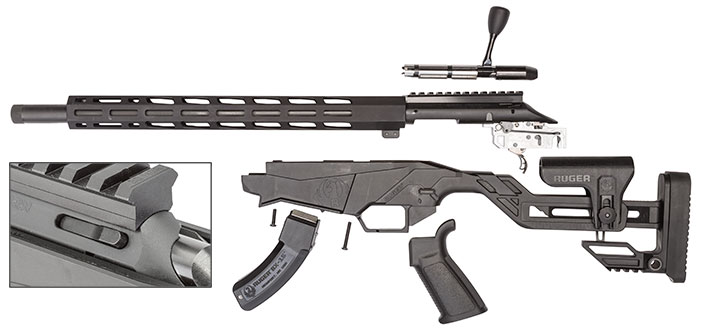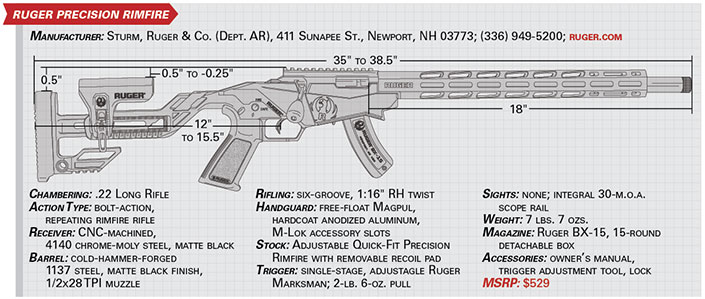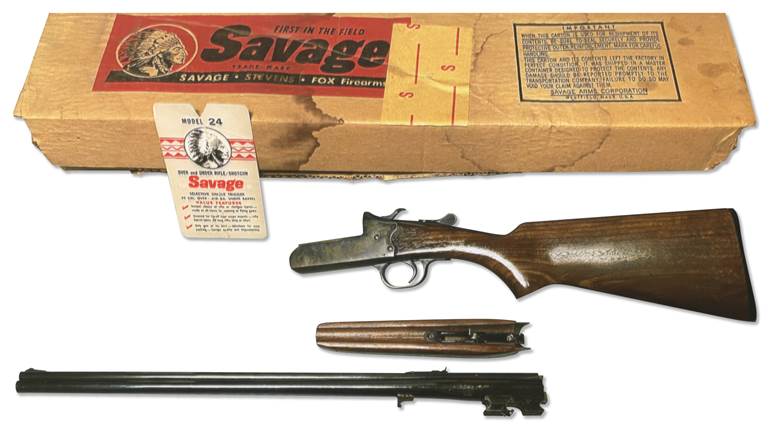
Ruger set the long-range tactical rifle market on its ear in 2015 when it released the center-fire Precision Rifle platform. Chambered in popular cartridges, including .308 Win. and 6.5 mm Creedmoor, this purpose-built bolt-action offered the benefits of a high-grade adjustable steel/aluminum chassis system at a significantly lower price while providing the down-range accuracy potential sought by long-range shooting enthusiasts. At the end of 2017, the Precision line was extended with the addition of a rimfire version chambered in .22 Long Rifle.
It was interesting to learn in the course of an interview with Matt Willson—the project manager for the Precision Rimfire rifle—that the work leading to this line extension started with a completely different goal in mind. With the popularity of rifle chassis systems on the rise, some manufacturers began offering chassis upgrades for existing rimfire rifles, and enterprising individuals at Ruger’s Mayodan, N.C., manufacturing plant suggested the same for the Ruger American Rimfire.
Looking over the available aftermarket chassis systems, the Mayodan staff decided it could develop a system of its own that would be of a higher quality with a more useful feature set. A prototype was in the works when the development team over at the Newport, N.H., facility caught wind of the project. That team recognized that the work of the Mayodan engineers was an ideal starting point for the rimfire-size Precision rifle it had in mind. The two projects were merged, and a properly scaled chassis rifle was produced to suit the needs of rimfire competitors as well as long-range center-fire rifle fans looking for a less expensive means of practicing for center-fire rifle competitions such as the Precision Rifle Series.
Like the center-fire version, the Precision Rimfire rifle is built around a CNC-machined, pre-hardened 4140 chrome-moly steel receiver topped with a removable 30-m.o.a. Picatinny optics rail. Some customers have questioned the installation of a rail with such a steep cant rather than one of 25, 20 or even 0 m.o.a.—all of which are better-suited to smaller or older scopes intended for shooting at distances of 50 yds. or less. The rail is one of the key features, however, that was specified as a direct result of Ruger’s customer testing.

About six months before the rifle was released, a team of company engineers gathered with a local league of precision rimfire competitors in North Carolina. They spent the day at a range shooting the Precision Rimfire prototype side-by-side with the rifles the league brought to the table. This tip-to-tail comparison provided invaluable information regarding the features the Precision Rimfire already had, and those it would need, in order to be successful within the competition community.
In most cases, competitors want rimfire platforms that mimic their preferred center-fire rifles as much as possible. As a result, it’s not uncommon for their rimfire guns to be topped with the same high-end, long-range optics as their bigger rifles. Since long-range optics benefit from a steeper rail cant, the Precision Rimfire ships with a 30-m.o.a. rail.

When it came time to determine the length of the rifle’s bolt throw, the engineers were faced with satisfying two preferences. Those who wished to use this gun as an understudy to the center-fire Precision wanted the longer 3" bolt throw of short-action center-fire models so as to preserve their muscle memory. Customers participating in rimfire competitions, however, preferred the shorter, faster 1½" bolt throw the smaller cartridge affords.
Ruger engineers devised a simple mechanical solution that is utterly reliable and was inexpensive to implement. The installation of a removable bolt stop spring clip (similar to the cartridge positioner spring) stops the bolt when it moves back far enough to eject a spent .22 Long Rifle cartridge case. Removing the clip from the bolt assembly allows the bolt to move all the way back to a distance that mimics that of the center-fire bolt’s travel. Removing or replacing the clip is a simple process that takes only a few seconds to accomplish.
One of the challenges in scaling down the Precision platform for rimfire ammunition was working out how to fit it with a removable barrel. The development team knew some competitors were going to shoot out the rifling faster than others, while some customers would want to immediately trade out the factory option for an aftermarket barrel. The American model rimfires are manufactured with fixed barrels, and the 10/22-type V-block system was not compatible with the Precision chassis.

The company opted to use a barrel nut arrangement similar to that of the AR-15 that can be removed using an AR-style armorer’s wrench. The 18" target-grade bull barrel is cold-hammer-forged from 4140 alloy steel. The muzzle is threaded at 1/2x28 TPI to accept muzzle devices and sound suppressors. A knurled thread protector is provided. The barrel’s diameter has been reduced from 0.920"—the bull barrel size common to the 10/22, to 0.860" because it is a better fit for the receiver and it reduces the weight of the barrel for improved balance. The vented, 15"-long, AR-type free-float handguard, which is supported by the barrel nut, is constructed of hard anodized aluminum with Magpul M-Lok slots along its length on the sides.
The Ruger American Rimfire bolt-action design paved the way for the Precision models to use the exceptionally popular 10/22 rotary magazine. This makes the rifle infinitely more appealing than if it required a new, proprietary magazine. It will accept all factory and most aftermarket magazines ranging from 10- to 25-round capacities. The rifle ships with the company’s 15-round BX-15 magazine because it’s often preferred for competition. It offers a balance of ammunition capacity for 10-target stages, it’s easy to grasp and insert for quick reloads, and it’s short enough not to bump into the bench top like the 25-round magazines sometimes do. An extended 10/22-style release lever is located at the back of the magazine well.
The bolt handle, which is fitted with an over-sized smooth knob, is on the right side of the receiver. The left-side, 45-degree safety selector and pistol grip are both AR-15 compatible. The bolt can be cycled, to clear the chamber, or removed from the receiver, with the selector set in the “safe” position. The safety selector is reversible, or it can be replaced with a bilateral lever. Ruger’s in-house polymer AR grip is supported by a single screw, allowing it to be traded out for a variety of AR-compatible grips.
One of the most important aspects of scaling down this platform for rimfire ammunition was the preservation of the feel and function of the adjustable Marksman trigger group, without sacrificing any of the safety features. Despite the changes to the internal geometry of the assembly—and a bit of extra milling to fit the modified receiver—the production rimfire trigger group uses the same housing as the center-fire version. It also has the exact same reach.

The trigger’s pull weight can be adjusted from 2 lbs., 4 ozs., up to 5 lbs. depending on the user’s preferences. An adjustment tool is stored in the stock under a removable panel behind the bolt assembly, which is easily accessed in the field. Some adjustable triggers can only be tuned after the action is removed from the stock. The Precision Rimfire’s screw is accessible via a small port in the trigger guard, so no disassembly is required. The rifle tested for this review arrived with the trigger pull set to a crisp, clean 2 lbs., 6 ozs., and I saw no reason to modify it.
The single most expensive component of the center-fire Precision is the machined aluminum chassis. It happens to be the heaviest component as well. Because the strength and inline recoil mitigation of an aluminum chassis are not required for use with a .22 rimfire, a one-piece, glass-filled nylon chassis is used instead. The reduced scale of the rimfire bolt assembly eliminates the need for a hinged shoulder stock, which trims down the weight and production costs even more. This polymer stock contributes to an unloaded weight that is 3 lbs. less than that of the center-fire models.
While the center-fire Precision has a more complex stock adjustment system with metallic components incorporated into it and multiple knobs and levers, the rimfire’s adjustable stock is all polymer with just one adjustment lever that governs the position and height of the cheek riser. The length of pull is adjustable from 12" to 15.5", with the thick, textured rubber recoil pad providing nearly an inch of that distance.

The stock is stiff and sturdy without any of the flimsiness that some polymer stocks exhibit. A metallic quick-detachable sling swivel is set into the stock at the base of the recoil pad to provide a connection point for a sling. A slotted, wedge-shaped extension features a 1.5" Picatinny rail to support the attachment of an adjustable monopod. The molded-in slot provides a tether point for a squeeze bag shooting rest.
I’ve never been all that shy about expressing the enjoyment I derive from spending an afternoon with a bench rest and a quality rimfire rifle printing satisfyingly tight groups downrange. Despite the now-ubiquitous matte-black finish and polymer furniture, the Precision Rimfire’s clean lines and tactical features make it stand out from the crowd. The rifle demonstrated a high degree of fit and finish throughout. The bolt assembly cycled smoothly shot after shot with a firm lockup each time the bolt was closed.
The single-stage Marksman trigger was a treat to use with its almost imperceptibly short stroke and a clean break. Although this rifle is over 2 lbs. heavier than the typical 10/22 carbine, it did have a good balance for off-the-bench shooting. Adjusting the cheek riser to a just right height was a quick, simple process.
I discovered the useful features and clear view provided by the Bushnell AR Optics 2-7X 32 mm (AR92732) rimfire scope a couple of years ago. As the name implies, this particular optic is intended for use with modern sporting rifles. Attached to this rifle using a Weaver SPR Optics Tactical rail mount, it was as if the Precision Rimfire and the Bushnell scope were designed specifically for each other.
The one mechanical issue to crop up in the course of testing was an occasional failure to properly eject a spent shell case when using the BX-15 magazine provided with the rifle. Instead of flying free of the receiver, the cases would simply spin around in the ejection port where they stayed until they were manually brushed or dumped out. This only occurred with the provided magazine. When using the other two additional BX-15 magazines I already had on hand, the problem disappeared completely with all loads fired. This minor inconvenience is not much of an issue for casual plinking. For those planning to use the Precision Rimfire for competition, it would be wise to test your magazines thoroughly before taking them out for a match.
With the formal five-shot-group accuracy testing completed, I went back through my records and compared the results with four of the most precise .22-cal. rimfires I have worked with up to this point. The best five-shot groups those rifles produced while I was pulling the trigger were between 0.79" and 0.80" in size when firing from a bench rest at 50 yds. The Precision Rimfire’s groups started at around the 0.80" mark and got smaller from there. The best five-shot group of 0.47" was produced using Eley’s Contact Target 42-gr. lead-round-nose load.

Based on the numerous positive reviews of the center-fire version of this platform, my expectations for the Precision Rimfire were high when I received it for testing. I’m glad to report that this gun met or exceeded my expectations on all fronts. While this rifle is obviously intended to serve as an understudy to the center-fire Precision, its target-grade accuracy, reliability and feature set make it an ideal option for rimfire competition. Like the larger version, this model’s price tag is significantly lower than other rifles in its class. The target-grade .22s I’ve tested in the past, including factory-assembled and at-home builds, have cost from $800 to $1,200. This rifle outshot them with a suggested retail price of $529. Real-world prices will likely be even lower, making the Ruger Precision Rimfire an even better value.







































